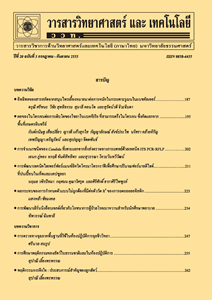ฤทธิ์ยับยั้งเอนไซม์แอลฟาอะไมเลสและฤทธิ์ต้านออกซิเดชันของสารสกัดหยาบจากผลมะเดื่ออุทุมพรด้วยเอทานอล
Main Article Content
บทคัดย่อ
บทคัดย่อ
โรคเบาหวานเกิดจากความผิดปกติของระบบเมแทบอลิซึม ซึ่งนำไปสู่ภาวะน้ำตาลในเลือดสูงเรื้อรัง ทำให้เกิดโรคแทรกซ้อนของอวัยวะสำคัญ ได้แก่ ไต จอประสาทตา หัวใจ เป็นต้น โดยมักสัมพันธ์กับการสร้างสารอนุมูลอิสระมากขึ้น การยับยั้งเอนไซม์ที่ช่วยย่อยอาหารจำพวกคาร์โบไฮเดรตในระบบทางเดินอาหาร เช่น เอนไซม์แอลฟาอะไมเลส เป็นอีกวิธีหนึ่งที่ช่วยชะลอการย่อยคาร์โบไฮเดรตและลดระดับน้ำตาลในเลือดหลังมื้ออาหารได้ งานวิจัยนี้มีวัตถุประสงค์เพื่อทดสอบฤทธิ์ยับยั้งการทำงานของเอนไซม์แอลฟาอะไมเลสและฤทธิ์ต้านออกซิเดชันของสารสกัดหยาบจากผลมะเดื่ออุทุมพร (Ficus racemosa Linn.) ด้วยเอทานอล โดยทดสอบฤทธิ์ยับยั้งการทำงานของเอนไซม์แอลฟาอะไมเลสใช้วิธีการวิเคราะห์น้ำตาลรีดิวซ์ (DNS method) ส่วนการทดสอบฤทธิ์ต้านอนุมูลอิสระใช้วิธี DPPH, ABTS และวิเคราะห์ความสามารถในการรีดิวซ์เฟอร์ริกของสารต้านอนุมูลอิสระใช้วิธี FRAP ผลการวิจัยพบว่าสารสกัดหยาบมีฤทธิ์ยับยั้งการทำงานของเอนไซม์แอลฟาอะไมเลสสูงสุด คิดเป็นร้อยละ 84.02±3.17 (ที่ความเข้มข้น 20 µg/mL) โดยมีค่า IC50 เท่ากับ 7.44±0.23 µg/mL และยังพบว่าสารสกัดหยาบมีศักยภาพในการต้านออกซิเดชัน ผลการทดสอบด้วยวิธี DPPH มีค่า IC50 เท่ากับ 128.84±52.89 µg/mL และวิธี ABTS มีค่า IC50 เท่ากับ 30.21±2.42 µg/mL ส่วนการทดสอบด้วยวิธี FRAP มีค่า FRAP value เท่ากับ 0.58±0.03 mM Fe2+/mg ของสารสกัดหยาบ สรุปได้ว่าสารสกัดหยาบจากผลมะเดื่ออุทุมพรมีฤทธิ์ฤทธิ์ยับยั้งการทำงานของเอนไซม์แอลฟาอะไมเลสและต้านออกซิเดชัน อย่างไรก็ตาม จำเป็นต้องศึกษาสารพฤกษเคมีที่สำคัญของสารสกัดหยาบที่มีฤทธิ์ดังกล่าว และศึกษาในมนุษย์เพิ่มเติม เพื่อยืนยันสมบัติของสารสกัดหยาบของผลมะเดื่ออุทุมพรในการบำบัดโรคเบาหวาน
คำสำคัญ : ผลมะเดื่ออุทุมพร; เอนไซม์แอลฟาอะไมเลส; สารต้านอนุมูลอิสระ
Article Details
References
[2] Ullah, A., Khan, A. and Khan, I., 2016, Diabetes mellitus and oxidative stress: A concise review, Saudi. Pharm. J. 24: 547-553.
[3] Giacco, F. and Brownlee, M., 2010, Oxidative stress and diabetic complica tions, Circ. Res. 107: 1058-1070.
[4] Standl, E. and Schnell, O., 2012, Alpha-glucosidase inhibitors 2012 – cardiovas cular considerations and trial evaluation, Diab. Vasc. Dis. Res. 9: 163-169.
[5] Kim, K., Rioux, L. and Turgeon, S.L., 2014, Alpha-amylase and alpha-glucosidase inhibition is differentially modulated by fucoidan obtained from Fucus vesiculosus and Ascophyllum nodosum, Phytochemis try 98: 27-33.
[6] Nutmakul, T., Pattanapanyasat, K., Soonthornchareonnon, N., Shiomi, K., Mori, M. and Prathanturarug, S., 2016, Anti plasmodial activities of a Thai traditional antipyretic formulation, Bencha-Loga-Wichian: A comparative study between the roots and their substitutes, the stems, J. Ethnopharmacol. 193: 125-132.
[7] คณะกรรมการพัฒนาระบบยาแห่งชาติ เรื่องบัญชียาจากสมุนไพร แนบท้ายประกาศบัญชียาหลักแห่งชาติ พ.ศ. 2559, ประกาศในราชกิจจานุเบกษา เล่ม 133 ตอนพิเศษ 86 ง., หน้า 11 , ลงวันที่ 12 เมษายน 2559.
[8] Veerapur, V.P., Prabhakar, K.R., Thippeswamy, B.S., Bansal, P., Srinivasan, K.K. and Unnikrishnan, M.K., 2012, Antidiabetic effect of Ficus racemosa Linn. stem bark in high-fat diet and low-dose streptozotocin-induced type 2 diabetic rats: A mechanistic study, Food Chem. 132: 186-193.
[9] Jain, R., Rawat, S. and Jain, S.C., 2013, Phytochemicals and antioxidant evalua tion of Ficus racemosa root bark, J. Pharm. Res. 6: 615-619.
[10] Joseph, B. and Raj, S.J., 2010, Phyto pharmacological and phytochemical properties of three Ficus species – an overview, Int. J. Pharma. Bio. Sci. 1: 246-253.
[11] ภัทรา พวงช่อ, นาฏศจี นวลแก้ว, 2556, ฤทธิ์ยับยั้งเอนไซม์แอลฟากลูโคซิเดสของสารสกัดพื้นบ้าน, ว.เภสัชศาสตร์อีสาน 9(1): 218.
[12] Ali, H. and Houghton, P.J., 2006, Soumyanath A. -Amylase inhibitory activity of some Malaysian plants used to treat diabetes, with particular reference to Phyllanthus amarus, J. Ethnopharmacol. 107: 449-455.
[13] Blois, M.S., 1958, Antioxidant determina tions by the use of a stable free radical, Nature 4617: 1199-1200.
[14] Re, R., Pellegrini, N., Proteggente, A., Pannala, A., Yang, M. and Rice-Evans, C., 1999, Antioxidant activity applying an improved ABTS radical cation decolorization assay, Free Radic. Biol. Med. 26: 1231-1237.
[15] Benzie, F.F. and Strain, J.J., 1996, The ferric reducing ability of plasma (FRAP) as a measure of: “Antioxidant Power”: The FRAP assay, Anal. Biochem. 239: 70-76.
[16] Hasan, N., Shirin, F., Khan, A.J., Mamun, A., Belal, H., Hasan, M., Islam, A., Tasnin, N., Karim, R.U., Asaduzzaman, Islam, D., Ara, T., Rahman, K.Z., Rahman, M. and Islam, M.A., 2017, Hypoglycemic, Hypolipidemic and Antibacterial Activity of Ficus racemosa Fruit Extract, Br. J. Pharm. Res. 16(1): 1-9.
[17] Zulfiker, A.H.M., Saha, M.R., Sarwar, S., Nahar, L., Hamid, K. and Rana, M.S., 2011, Hypoglycemic and in vitro antioxidant activity of ethanolic extracts of Ficus racemose Linn. Fruits, Am. J. Sci. Ind. Res. 2, 391-400.
[18] Amin, M., Bhakta, S. and Das, S.K., 2015, Anti-diabetic potential of Ficus racemosa: Current state and prospect especially in the developing countries, J. Biosci. Agric. Res. 5: 65-72.
[19] Deepa, P., Sowndhararajan, K., Kim, S. and Park, S.J., 2018, A role of Ficus species in the management of diabetes mellitus: A review, J. Ethnopharmacol. 215: 210-232.
[20] Rathinavelusamy, P., Mazumder, P.M., Sasmal, D. and Jayaprakash, V., 2014, Evaluation of in silico, in vitro -amylase inhibition potential and antidiabetic activity of Pterospermum acerifo lium bark, Pharm. Biol. 52: 199-207.
[21] Sumi, S.A., Siraj, A., Hossain, A., Mia, S., Afrin, S. and Rahman, M., 2016, Investigation of the key pharmacological activities of Ficus racemosa and analysis of its major bioactive polyphenols by HPLC-DAD, Evid. Based Complement. Alternat. Med. 2016: 1-9.
[22] Ramana, G., Reddya, C.S., Raob, CV., 2011, In-vitro and in-vivo anti-oxidant activity of Ficus racemosa Linn. fruit extract and Aegle marmelos root and leaf extracts, J. Pharm. Res. 4: 2078-2081.
[23] Veerapur, V.P., Prabhakar, K.R., Parihar, V.K., Kandadi, M.R., Ramakrishana, S., Mishra, B., Mishra, B., Satish Rao, B.S., Srinivasan, K.K., Priyadarsini, K.I. and Unnikrishnan, M.K., 2009, Ficus racemosa stem bark extract: A potent antioxidant and a probable natural radioprotector, Evid. Based Complement. Alternat. Med. 6: 317-324.
[24] Deshmukh, T.A., Yadav, B.V., Badole, S.L., Bodhankar, S.L. and Dhaneshwar, S.R., 2007, Antihyperglycaemic activity of petroleum ether extract of Ficus racemose fruits in alloxan induced diabetic mice, Pharmacol. Online 2: 504-515.

